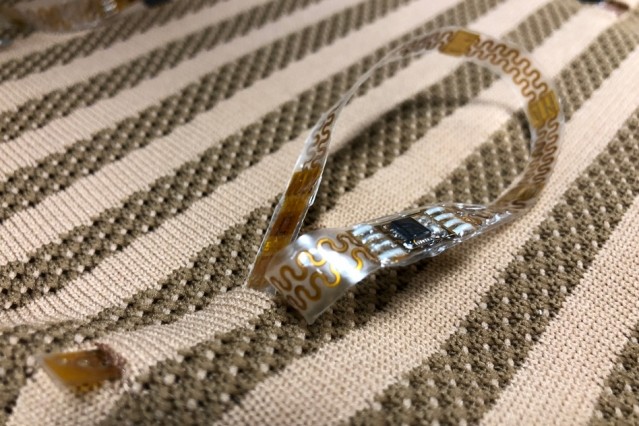Although we’ve recently seen a number of “electronic skin” sensor patches that monitor the wearer’s vital signs, the things do have their drawbacks. Scientists at MIT have therefore developed what may be a better alternative, in the form of a vitals-monitoring shirt.
Electronic skin patches typically take the form of a thin sheet of silicone with electronic components embedded inside. Adhered to the skin, they’re capable of monitoring factors such as the wearer’s heart rate, skin temperature and respiration – that data gets wirelessly transmitted to a nearby mobile device or computer.
Unfortunately, though, a single patch can only monitor one part of the body. And while multiple patches can be placed on different parts of one person, taking that approach sometimes gets complicated, especially if each device requires its own onboard power supply. Additionally, the patches may fall off during vigorous activity, and don’t always stand up well to repeated or long-term usage.
Clothing made of so-called “smart fabrics” has therefore been developed as an alternative to the patches. Often incorporating electrically-conductive yarn, these textiles cover wider areas of the body, and can easily be taken on and off. In many cases, however, they’re not very stretchable, compromising their ability to maintain sensory contact with the wearer’s skin.
That’s where the shirt made with MIT’s Electronic Textiles Conformable Suit (E-TeCS) technology comes in.
It’s constructed of a stretchy, moisture-wicking polyester blend that clings to the contours of the user’s body, not unlike an athletic compression shirt. Woven into narrow channels within that fabric are a series of long, flexible, electronic sensory strips. These make contact with the skin via multiple holes in the underside of each channel, and are all linked to a single detachable module that houses a microprocessor, Bluetooth transmitter, and rechargeable lithium-polymer battery.

MIT
In its current prototype form, the shirt measures skin temperature via 30 separate sensors, plus it tracks the wearer’s movements, heartbeat and respiration rate utilizing a single accelerometer. When the garment needs to be washed, its processing module is simply pulled off. The waterproof epoxy-coated sensory strips can be left in place, although it is possible to remove them from their channels so they can be transferred to another shirt.
The researchers state that it should be relatively easy to mass-produce shirts and other clothing that incorporates E-TeCS technology, in a variety of styles and sizes. Such garments could ultimately find use in assessing the performance of athletes, the health of patients, or even the well-being of astronauts on space missions.
A paper on the research, which is being led by Asst. Prof. Canan Dagdeviren, was recently published in the journal npg Flexible Electronics.
Source: MIT
Source of Article